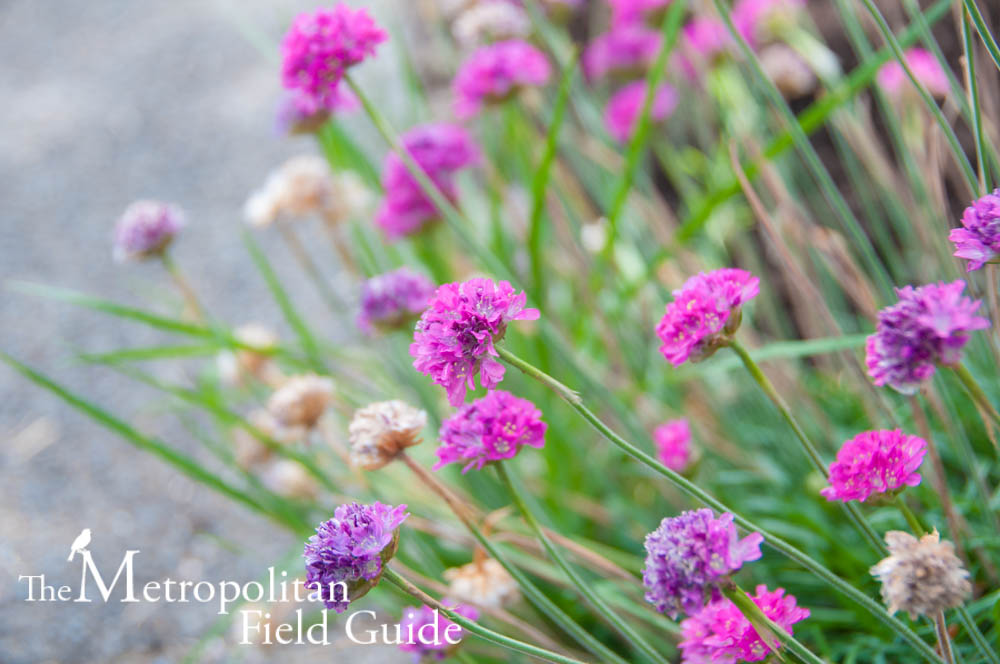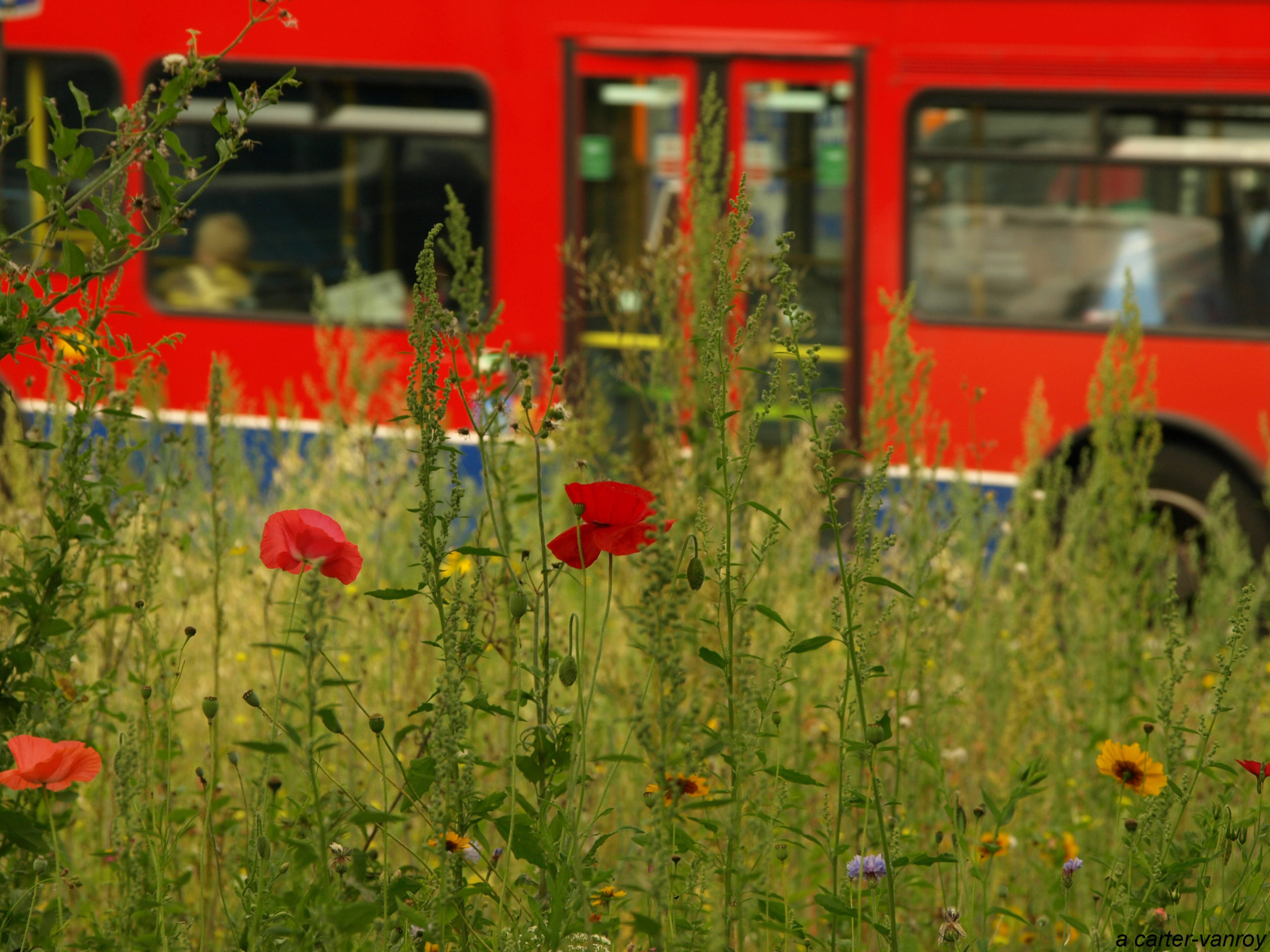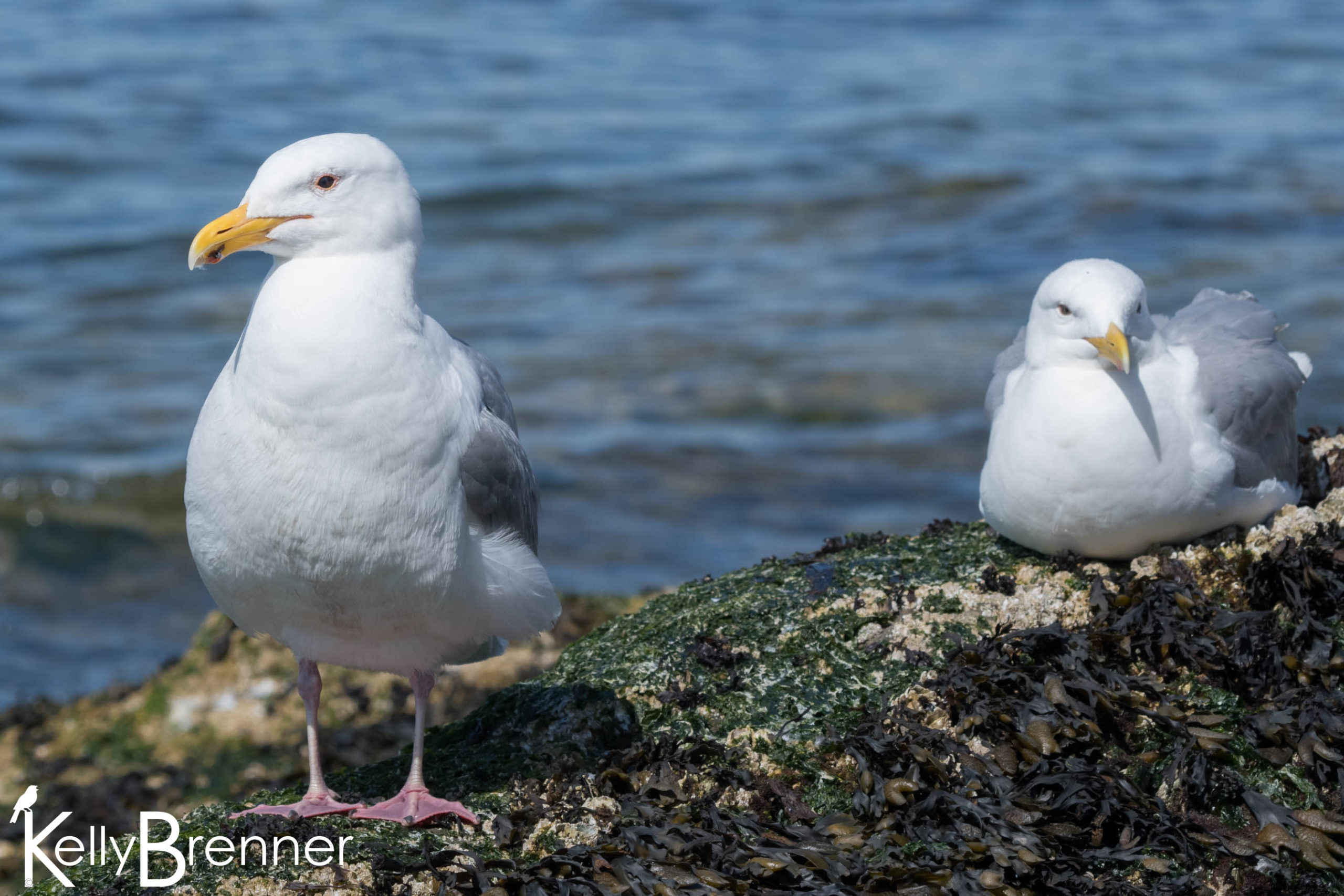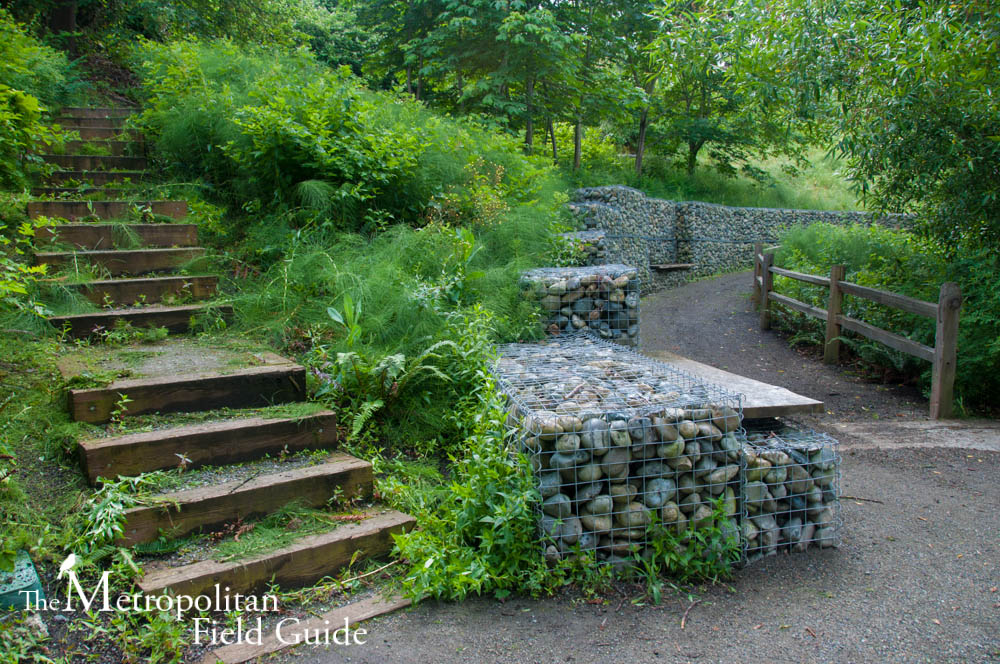The Pollinator Pathway is planned along a one-mile stretch in Seattle from Seattle University to Nora’s Woods replacing grass strips with pollinator gardens. The brainchild and creation of Sarah Bergmann, the Pollinator Pathway currently consists of two installed gardens with another 16 planned and has 20 total homeowners signed up to participate. I visited one of the gardens where Sarah was kind enough to meet me and tell me all about this fascinating project. The first garden was installed in July of 2008 after much planning and work and has been a great start with a lot learned. The gardens are created for the space between the sidewalk and the street and range in size from 4′ to 12′ wide and for the most part are currently grass.
At one end is Seattle University which has been a supporter of the project, themselves having a number of beneficial gardens on their own campus including a biodiversity garden, rain garden and wildlife garden. At the other end is a tranquil park called Nora’s Woods, a sanctuary in the city. The street that runs between them is Columbia, a relatively hilly, mostly residential street with some roundabouts and a number of great street trees, new and mature.
The project idea had a number of influences, one of the first (and perhaps most important) was Sarah’s interest in native pollinators and their specialized relationship with plants. Also influential was learning about Colony Collapse Disorder in European honey bees. While European honey bees are not a native species, we are undeniably dependent on them for a large percentage of our agriculture. Other interesting projects that played an influential role were the Yellowstone to Yukon Conservation Initiative, Freedom to Roam, The Great Sunflower Project and The High Line in Manhattan.
The gardens are part practical, part educational and part theoretical. In one part the gardens serve an ecological function for a range of pollinators including bees such as bumblebees and mason bees, butterflies, hummingbirds, flies, beetles, ants and potentially even moths. It’s also an educational feature serving to inform the neighbors and all other visitors about the importance of pollinators and how to garden for them. It’s also theoretical because this sort of project has not been done in this region before so a lot of it is a trial and error and could serve as a potential basis for scientific study. There are limited resources available about the relationship between specific pollinator species and specific plants for this region. Often the Pacific Northwest is lumped together as one region, but in truth there are a number of slightly different climates that, although they are similar, will affect growing and blooming times and hibernation.
The first step in the project is finding the right plants for the right pollinators. The first two gardens have already yielded great results and much has been learned about these relationships. A designer was brought in to create several templates that would be tiled in the various gardens. There are templates for gardens in sun, shade or a combination and the website has a plant list that corresponds to the templates and offers information about what types of pollinators are attracted to the various plant species. The website acts as the main source of information for the homeowner to learn more about their gardens and the pollinators that inhabit them.
So far the project has worked thanks to a neighborhood grant through the city of Seattle. This helps to get the materials and organize work parties to install the garden. The homeowner is then only responsible for maintenance of the garden. Most of the plants are natives and well adapted to the local climate so they need little maintenance and are drought tolerant once established.
There are a lot of challenges in the plantings, one reason being a 3′ height limit due to the location of the gardens along the street presenting a potential visibility issue. One of the most challenging aspects for anyone without endless patience is waiting for the plants to become established and start to grow and fill in the gardens. There is a focus on native plants, although other beneficial, non-native plants have been included as well. Some of the plants that have been selected include Oregon Grape, Sword Fern, Kinnikinnick (featured here last week), Wood Sorrel, Coastal Strawberry and a variety of annuals and perennials including Nootka Lupine, Columbia Lewisia, Red Columbine and Common Thrift. In yards that don’t already have trees more will be planted.
One of the main goals of this project was a systems thinking approach, how to plan in a holistic way and to address the complexity of ecosystems. The street grid is not something that is going to change so how can it be used as a benefit instead of an impediment. One day Sarah hopes to see this project implemented throughout not only Seattle, but in other cities across the country. There has been a good response locally from neighbors and an ecology professor from Seattle University is planning to integrate the Pollinator Pathway into the classroom. Several articles have also appeared in the local newspapers.
There is a great deal of potential for the Pollinator Pathway. To anyone interested in pollinators it’s enough to get them giddy, but it has the potential to benefit so much more than pollinators. Starting out is always the hardest part because someone has to figure out what works and what does not, but once that has been done, then the sky is the limit. It could become so successful that the neighbors start to incorporate the design into their yards as well. There are many roundabouts along the street that could be adopted by neighbors to turn into further habitat as I talked about in the Unexpected Habitat post. Insect houses could also be installed in the gardens or in neighbors yard such as the ones detailed in the Beyond the Hive post. Once the variety of pollinators becomes abundant, it’s likely that the species that prey on them will also move into the neighborhood. Eventually bird and bat houses could be incorporated in the street trees or on neighbors houses. Once a number of gardens have been installed it would make an excellent setting for a block party or street fair, especially for pollinator week. It could also serve as a great educational tool for organizations, schools (primary to university), and homeowners too.
I find this project extremely exciting and the potential of it is amazing. Not only could other cities benefit from this project but organizations such as Audubon could really adopt it as well. It’s also something that could really bring neighbors together through a common interest and work parties. Hopefully more gardens along the Pollinator Pathway will be installed soon and I know I’ll be tracking the progress.
View some more photos of the Pollinator Pathway at The Metropolitan Field Guide Flickr page.
Further Reading::
Yellowstone to Yukon Conservation Initiative
Native bees play bigger role as honeybees decline:: Seattle Times
Art as Landscape: The Pollinator Pathway:: The Seattle Post-Intelligencer
Pollinator Pathway: Vital Ecology in the Emerald City:: GOOD
Seattle’s Pollinator Pathway:: Local Ecologist








Enjoyed reading this post — rich detail. Your point about system design is well taken. A Berkeley, CA plug: in the Le Conte neighborhood, one of the traffic circles has been converted into butterfly habitat as well as the school yard across from the rotary.
I would like to be on your email list.
Hi Maria, you can sign up to be notified of new posts via email on the top right-hand of this page in the box titled ‘Follow The Metropolitan Field Guide’. The email subscription form is the icon on the right. Thank you for visiting!
I’m writing from restreets.org, a multi-disciplinary collaboration focused on the planning, design and construction of streets as a method for improving our built environment.
We’re publishing a book and are including a case study write-up of the Pollinator Pathway project. Do you own the rights to the images you’ve posted on your blog? If so, might you be willing to send me high-res versions, with permission to publish, as well as any photo credit information?
Your help is much appreciated!
Catherine Courtenaye
http://www.restreets.org
Hi Catherine,
Thank you for stopping by my website, I do own the copyright to the photographs in this post, but the planting template is owned by the Pollinator Pathway. I’d be happy to discuss selling the images for use in your book, you can contact me via the contact form under ‘About’ in the menu at the top of the website..
A neighbor over by Wisconsin where I live by me has a fit every time and threatens me, I go out with my lawn mower sometime using it without the blade going… most times it’s to cut my field path going for my National Registered Garden with a few different registries through the internet…I want to monitor it for pests and trespassers, set up artist who want to damage all my hard work and bought store decors that give the garden ( Not food!) the animals safe place to be without cause of danger from a personal jealousy artist and a nice looking area for passers to say that is really cool!! By law I have the right to make my own pollinator garden under the laws digression and have a wild life area for watching wild animals like deer rabbits or fox or even turkey, carne excetra to feed and thrive! I want everyone’s respect as hunters get and that No trespassing respect also and or anyone else would get the freedom to do what I want without disturbance or blockage or threats! I also like photography hoping for maybe a photo contest! also they would set me up with a crimes I did not do, I have not ever been arrested for anything…. so I don’t know why they are so aggressive… I spoke to the registries and they said lawyer would be interested entrapment issues, fraud or threats in this as you are registered and legal not state or county wild life registered but you are under acknowledgment of the Wild life and fish division, so they might be ones to get help and they would!
Also individual rights division and police surely would help if it came to that situation! I am keeping all records or store products etcetera, items and I do not plan on a business, it’s personal enjoyment CONTSTUTIONAL RIGHTS of my property! Amish don’t have that problem and we have many around us who have beautiful gardens!
I called them up and yes that’s what they said so I am working g at putting more décor I a little at a time exercise is good for anyone and healthy and f interesting good times!Anyway, good thought to pass onto other wildlife and pollinator enthusiast!
I guess the people miss understood what was being done and now the problem has ben acknowledged for it’s conservation aspects and for it’s beauty and hoping to help that of the butterflies and wildlife as they pass through or what ever they may do in the conservational area and I am thankful for their thoughtfulness towards my conservation project! God Bless them, they actually now feel it’s a good idea even for their property!